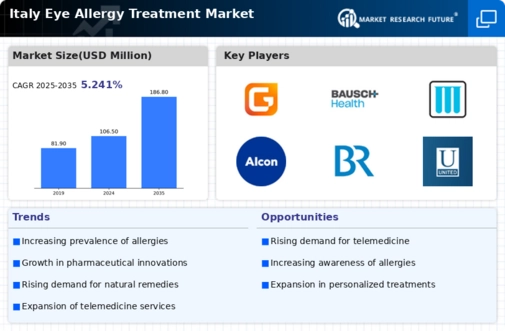Rising Environmental Allergens
The prevalence of environmental allergens in Italy is a significant factor influencing the eye allergy-treatment market. Factors such as urbanization, climate change, and increased pollution levels have led to a rise in allergens like pollen, dust mites, and mold. According to recent studies, around 25% of Italians report experiencing allergic reactions due to environmental factors, which directly impacts the demand for eye allergy treatments. As the population becomes more susceptible to these allergens, the market for effective therapeutic solutions is likely to expand. This trend suggests that companies focusing on developing innovative treatments tailored to combat these specific allergens may find substantial opportunities within the eye allergy-treatment market.
Increasing Awareness of Eye Allergies
The growing awareness of eye allergies among the Italian population is a crucial driver for the eye allergy-treatment market. As more individuals recognize the symptoms and triggers of eye allergies, there is a corresponding increase in demand for effective treatments. Public health campaigns and educational initiatives have contributed to this awareness, leading to a rise in consultations with healthcare professionals. In 2025, it is estimated that approximately 30% of the Italian population experiences some form of allergic conjunctivitis, which underscores the need for targeted treatment options. This heightened awareness not only drives market growth but also encourages pharmaceutical companies to innovate and expand their product offerings in the eye allergy-treatment market.
Regulatory Support for Allergy Treatments
Regulatory support for allergy treatments in Italy plays a pivotal role in shaping the eye allergy-treatment market. The Italian Medicines Agency (AIFA) has implemented favorable policies to expedite the approval process for new allergy medications, encouraging innovation and competition. This regulatory environment fosters the development of novel therapies, including biologics and immunotherapy, which are gaining traction in the market. As of 2025, it is anticipated that the introduction of new treatment options will enhance patient access and improve overall treatment outcomes. The supportive regulatory framework not only benefits patients but also stimulates growth within the eye allergy-treatment market, as companies are incentivized to invest in research and development.
Growing Demand for Over-the-Counter Solutions
The rising demand for over-the-counter (OTC) solutions is a notable driver in the eye allergy-treatment market. Many consumers prefer accessible and convenient treatment options that do not require a prescription. In Italy, the OTC segment is expected to account for approximately 40% of the total market share by 2025, driven by the increasing self-medication trend. This shift is influenced by factors such as busy lifestyles and the desire for immediate relief from allergy symptoms. Consequently, pharmaceutical companies are focusing on developing effective OTC products, including antihistamine eye drops and allergy relief sprays, to cater to this growing consumer preference within the eye allergy-treatment market.
Technological Advancements in Treatment Delivery
Technological advancements in the delivery of eye allergy treatments are reshaping the eye allergy-treatment market. Innovations such as sustained-release formulations and smart delivery systems are enhancing the efficacy and convenience of treatments. For instance, the introduction of eye drops with extended-release capabilities allows for less frequent dosing, improving patient compliance. In 2025, the market for advanced delivery systems is projected to grow by 15%, reflecting the increasing preference for user-friendly treatment options. These advancements not only improve patient outcomes but also create a competitive edge for manufacturers in the eye allergy-treatment market, as they strive to meet the evolving needs of consumers.






















Leave a Comment